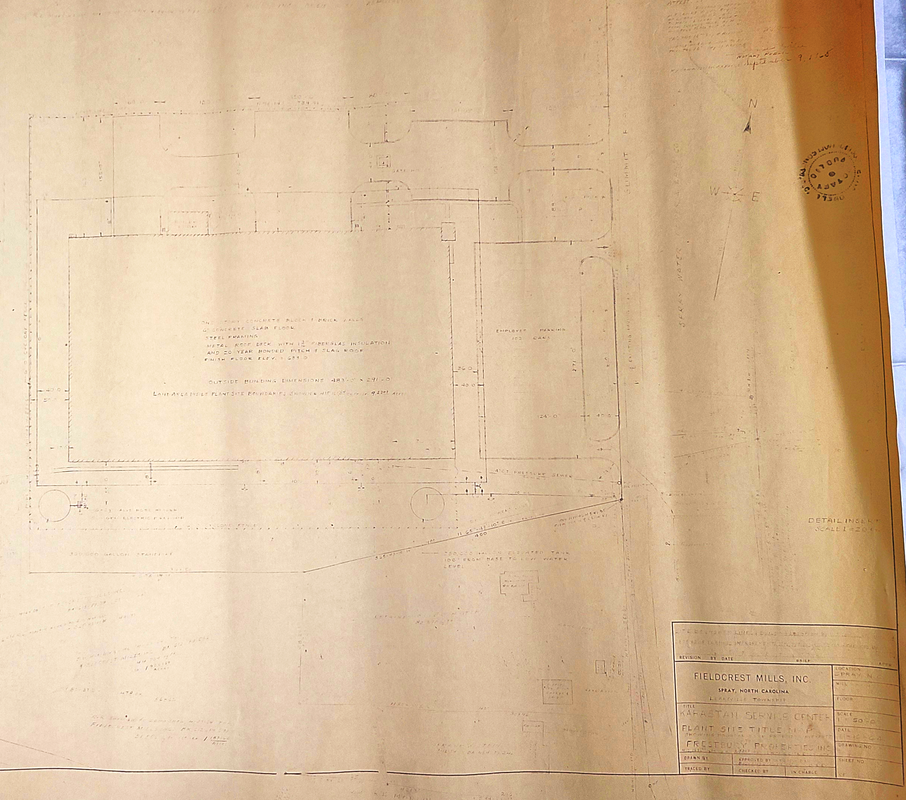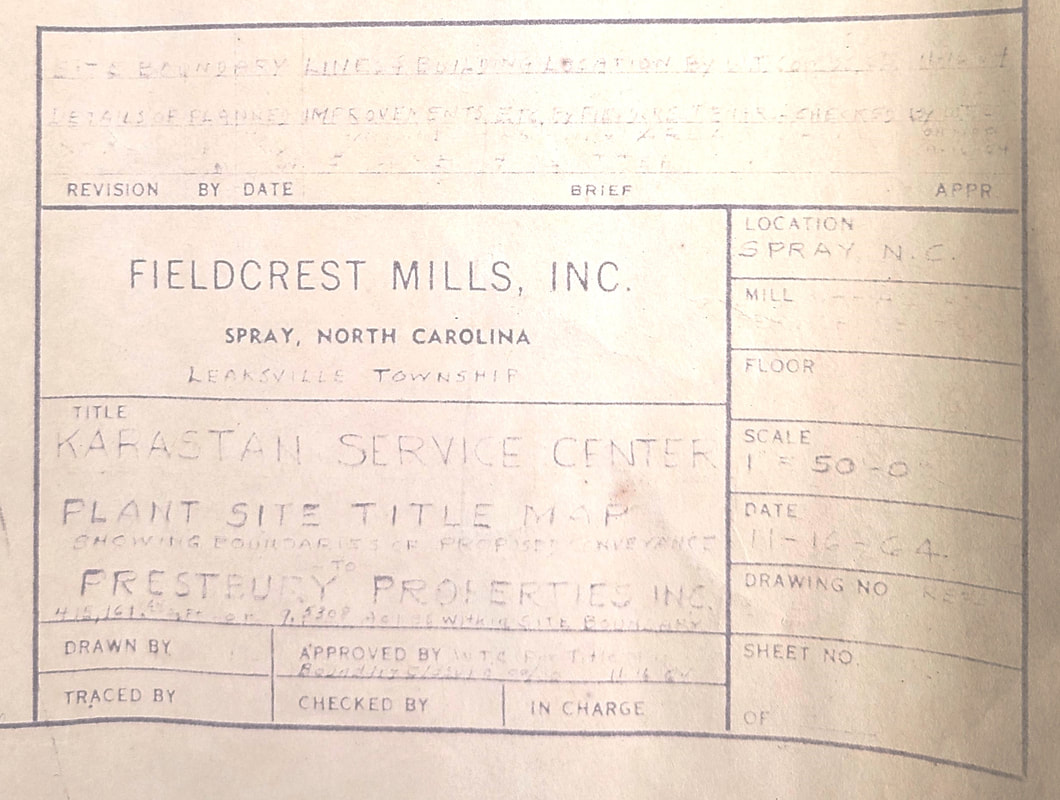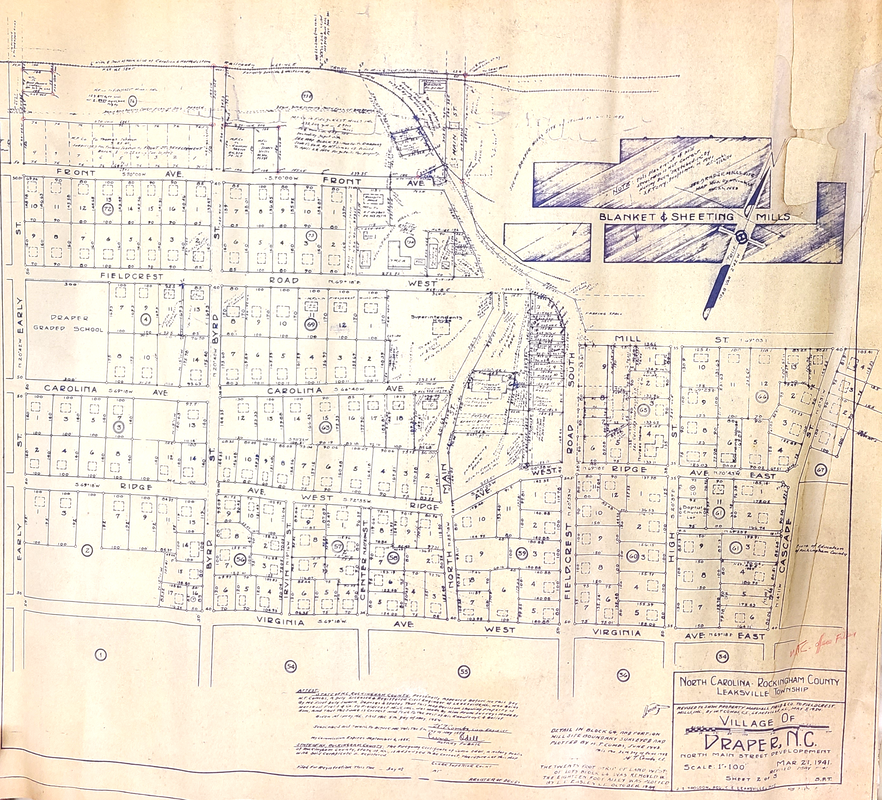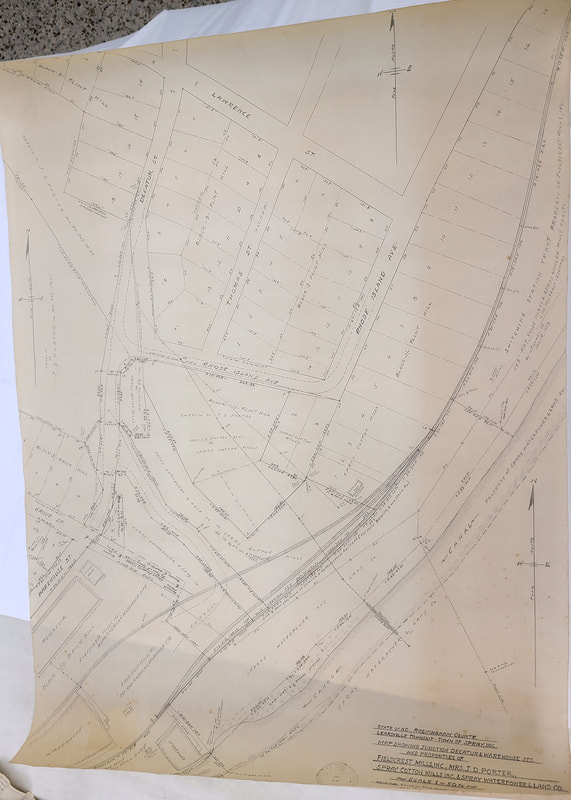|
Mills heavily impacted the development of cities and towns throughout Rockingham County, and North Carolina more broadly. Historical maps allow some insight into the ways that these places looked throughout different points in time. Through historical maps, it is possible to learn about how interactions between the mills and the communities that were centered around them influenced one another and changed over time. John M. Morehead opened the Leaksville Cotton Mill in 1839.[1] It was one of the first textile mills opened in Rockingham County. In 1840, the Leaksville Cotton Mill employed 40 people, and by 1860, the census documented 80 women and 25 men working there.[2] Following the Civil War, Morehead would hire only white workers to work in his textile mill.[3] By 1890, there was a cotton mill in Reidsville, soon followed by Mayo Mills at Mayodan, the Spray Cotton Mill, and the mill at Avalon, which burned down in 1911, and was never reconstructed.[4] Benjamin Franklin Mebane would oversee the establishment of a number of additional mills in the late 1800s and early 1900s, including the Nantucket Mill, American Warehouse, and Lily Mill, among several others. Mebane had established so many mills that he did not have the money to fund all of them properly and Marshall Field and Company ended up taking control of his mills.[5] In the early 1900’s, one of the mills in Draper was owned by the German-American Co. in an area referred to as “the Meadows.” In 1912 the mill was purchased by the Marshall Field and Company, who also bought several of the mills in the surrounding area.[6] In 1953 Marshall Field and Company sold all of their mills in Rockingham County to Fieldcrest Mills, Inc.[7] Entire cities in Rockingham County were developed due to their proximity to a textile mill. The town of Draper is an example. Following the construction of the mill, the Rockingham Land Company sought to develop the town, a railroad was constructed, schools opened, churches were established, and the Bank of Draper was opened in 1920. Draper incorporated just under 50 years after the construction of the mill, in 1949.[8] The importance of the textile mills to the populace of Rockingham County historically cannot be overstated. The 1962 Hill’s Leaksville, Spray and Draper (Rockingham County, N.C.) City Directory refers to the mills as the “economic backbone of the Tri-Cities.”[9] Additionally, a 1977 report on the community by the County’s library reported that such a large percentage of the population of Rockingham County was employed in the textile industry that any economic downturn regarding textiles on a national level “would adversely affect Rockingham County’s entire economy.”[10] Evidence of the importance of mills to the county can be seen in many of the historical maps that are in the possession of the MARC. Of particular interest is a collection of several hundred maps that were originally owned by the Rockingham County government, which are largely maps made by engineers, for the purpose of delineating land ownership, rather than maps used for navigation or other purposes. Several of these maps include textile mill sites, including the Nantucket Mill site and the Spray Cotton Mill site, as well as several other non-mill properties owned by Fieldcrest Mills, Inc. These maps offer a unique glimpse into the past, which provide a visual framework for understanding the reach of the mills in various communities in Rockingham County, and the impact that textiles made in these local mills had on broader culture. One example of this is the map of the Karastan Service Center, owned, at the time, by Fieldcrest Mills, in Spray. The map dates from November 16, 1964. The Karastan Mill in Eden closed down operations in 2021, after 93 years of operation.[11] The Karastan Mill was a long term mainstay in Spray, and then Eden, outlasting many of the other mills in the area. Throughout its history, it was owned by Marshall Field & Co., Fieldcrest Mills, and Mohawk Industries. Karastan rugs are well known, and this mill shows how Eden has had a national influence. There are several other mills that are depicted in this map collection. With a slightly larger focus, another map is titled Junction of Decatur and Warehouse Streets and Properties of Fieldcrest Mills, Inc., Mrs. J.D. Porter, Spray Cotton Mills, Inc., and Spray Water Power and Land Co. Also owned by Fieldcrest Mills at times, this map was created in December of 1964. Spray Cotton Mills was originally a part of the Spray Water Power and Land Co., which was started by James Turner Morehead in 1889. Soon after the development of Spray Water Power and Land Co., James Turner Morehead shifted control of the company to B. Frank Mebane and W. R. Walker, who constructed the Spray Cotton Mills in 1896.[12] The following year, the Spray Cotton Mills were sold to Karl von Ruck, who is best known for studying and helping to create the tuberculosis vaccine.[13] The Spray Cotton Mills eventually closed down after 100 years in 2001. In January of 2023, a fire completely burned the main building in this complex. The mill was being sold or renovated for new uses when the fire broke out. [14] Both the map of Karastan Mills and Spray Cotton Mills are from 1964, just three years before Spray, Draper, and Leaksville merged to become Eden, a time of change for the community. The historical maps of Rockingham County depict important developments in communities and can provide important insights into the county’s textile mill history. Footnotes: [1] Hill’s Leaksville, Spray and Draper (Rockingham County, N.C.) City Directory (Richmond: Hill Directory Company, 1962), 17. [2] Lindley S. Butler, Rockingham County: A Brief History, (Raleigh: North Carolina Department of Cultural Resources Division of Archives and History, 1982), 42-43. [3] Butler, 58. [4] Butler, Rockingham County: A Brief History, 60, 66, 79. [5] Butler, Rockingham County: A Brief History, 79. [6] Hill’s Leaksville, Spray and Draper (Rockingham County, N.C.) City Directory, 18 [7] Butler, Rockingham County: A Brief History, 79. [8] Butler, Rockingham County: A Brief History, 72. [9] Hill’s Leaksville, Spray and Draper (Rockingham County, N.C.) City Directory, 18 [10] Rockingham County: The Library and the Community,” eds. Joyce Leeka, Deborah McCabe, and Deborah Russell, (Eden: Style-Kraft, 1977), 30. [11] Andrea Richards, “The End of the Wonder Rug,” New York Times, June 5, 2021, https://www.nytimes.com/2021/06/05/style/oriental-rugs-carpet-karastan-where-made.html. [12] Lindley S. Butler, “Spray Water Power and Land Company,” NCPedia, 2006. https://www.ncpedia.org/spray-water-power-and-land-company. [13] “Tuberculosis Vaccine Perfected in Asheville, 1912,” NC Department of Natural and Cultural Resources, November 5, 2016, https://www.ncdcr.gov/blog/2016/11/05/tuberculosis-vaccine-perfected-asheville-1912. [14] Susie C. Spear, “Sacred to Some, Only Ashes and Memories Remain After Spray Cotton Mills Fire,” Greensboro News and Record, January 27, 2023, https://greensboro.com/news/local/sacred-to-some-only-ashes-and-memories-remain-after-spray-cotton-mills-fire/article_d6e4911a-9dc5-11ed-96ec-47fa42a20e65.html Bibliography:
Butler, Lindley S. Rockingham County: A Brief History. Raleigh: North Carolina Department of Cultural Resources Division of Archives and History, 1982. Butler, Lindley S. “Spray Water Power and Land Company.” NCPedia. 2006. https://www.ncpedia.org/spray-water-power-and-land-company. Hill’s Leaksville, Spray and Draper (Rockingham County, N.C.) City Directory. Richmond: Hill Directory Company, 1962. Richards, Andrea. “The End of the Wonder Run.” New York Times, June 5, 2021. https://www.nytimes.com/2021/06/05/style/oriental-rugs-carpet-karastan-where-made.html. Rockingham County: The Library and the Community.” Eds. Joyce Leeka, Deborah McCabe, and Deborah Russell. Eden: Style-Kraft, 1977. Spear, Susie C. “Sacred to Some, Only Ashes and Memories Remain After Spray Cotton Mills Fire.” Greensboro News and Record, January 27, 2023, https://greensboro.com/news/local/sacred-to-some-only-ashes-and-memories-remain-after-spray-cotton-mills-fire/article_d6e4911a-9dc5-11ed-96ec-47fa42a20e65.html “Tuberculosis Vaccine Perfected in Asheville, 1912.” NC Department of Natural and Cultural Resources, November 5, 2016, https://www.ncdcr.gov/blog/2016/11/05/tuberculosis-vaccine-perfected-asheville-1912.
0 Comments
Leave a Reply. |
Articles
All
AuthorsMr. History Author: Bob Carter, County Historian |
|
Rockingham County Historical Society Museum & Archives
1086 NC Hwy 65, Reidsville, NC 27320 P.O. Box 84, Wentworth, NC 27375 [email protected] 336-634-4949 |




 RSS Feed
RSS Feed
